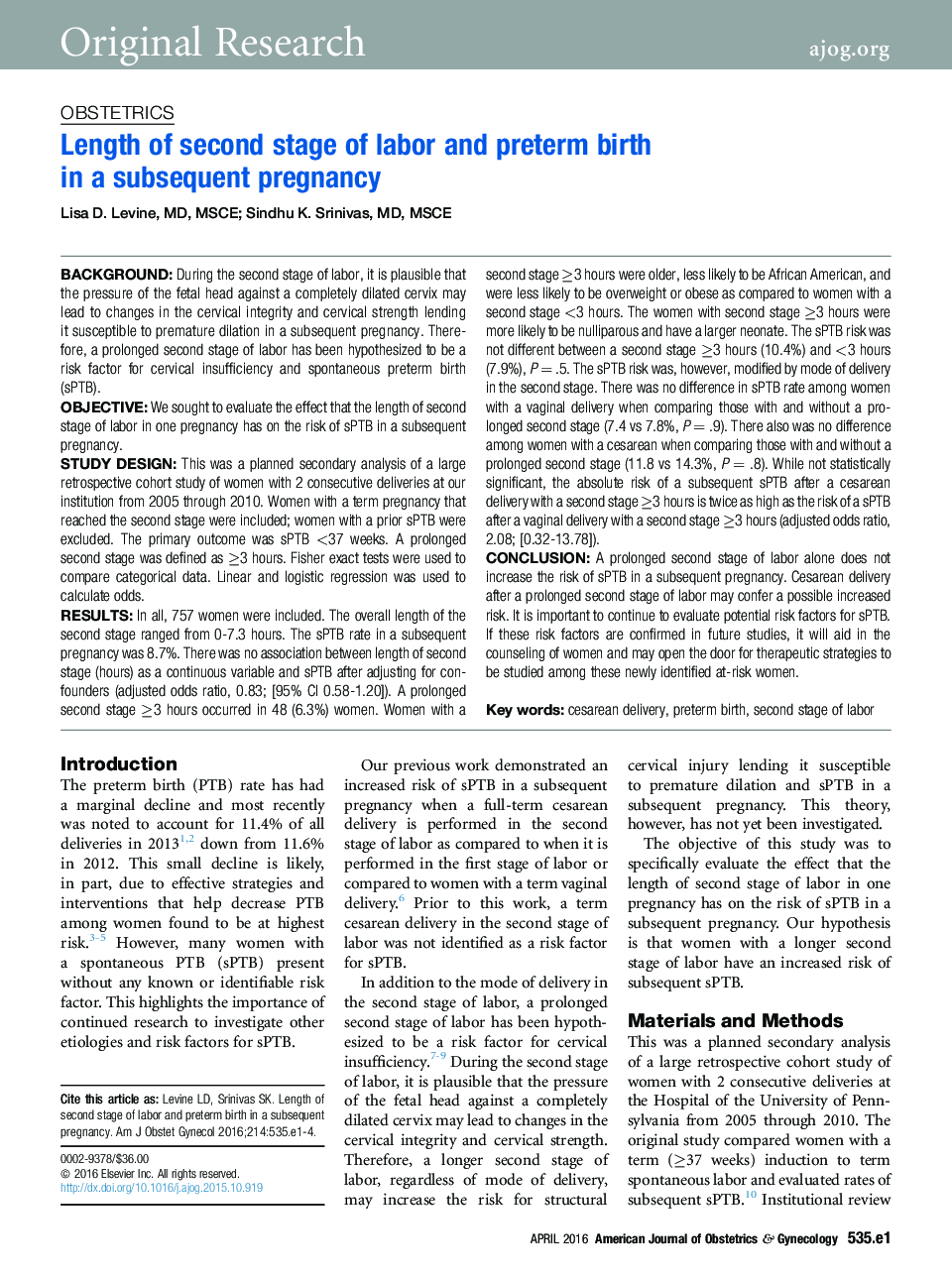| کد مقاله | کد نشریه | سال انتشار | مقاله انگلیسی | نسخه تمام متن |
|---|---|---|---|---|
| 6144157 | 1594892 | 2016 | 4 صفحه PDF | دانلود رایگان |
BackgroundDuring the second stage of labor, it is plausible that the pressure of the fetal head against a completely dilated cervix may lead to changes in the cervical integrity and cervical strength lending it susceptible to premature dilation in a subsequent pregnancy. Therefore, a prolonged second stage of labor has been hypothesized to be a risk factor for cervical insufficiency and spontaneous preterm birth (sPTB).ObjectiveWe sought to evaluate the effect that the length of second stage of labor in one pregnancy has on the risk of sPTB in a subsequent pregnancy.Study DesignThis was a planned secondary analysis of a large retrospective cohort study of women with 2 consecutive deliveries at our institution from 2005 through 2010. Women with a term pregnancy that reached the second stage were included; women with a prior sPTB were excluded. The primary outcome was sPTB <37 weeks. A prolonged second stage was defined as â¥3 hours. Fisher exact tests were used to compare categorical data. Linear and logistic regression was used to calculate odds.ResultsIn all, 757 women were included. The overall length of the second stage ranged from 0-7.3 hours. The sPTB rate in a subsequent pregnancy was 8.7%. There was no association between length of second stage (hours) as a continuous variable and sPTB after adjusting for confounders (adjusted odds ratio, 0.83; [95% CI 0.58-1.20]). A prolonged second stage â¥3 hours occurred in 48 (6.3%) women. Women with a second stage â¥3 hours were older, less likely to be African American, and were less likely to be overweight or obese as compared to women with a second stage <3 hours. The women with second stage â¥3 hours were more likely to be nulliparous and have a larger neonate. The sPTB risk was not different between a second stage â¥3 hours (10.4%) and <3 hours (7.9%), P = .5. The sPTB risk was, however, modified by mode of delivery in the second stage. There was no difference in sPTB rate among women with a vaginal delivery when comparing those with and without a prolonged second stage (7.4 vs 7.8%, P = .9). There also was no difference among women with a cesarean when comparing those with and without a prolonged second stage (11.8 vs 14.3%, P = .8). While not statistically significant, the absolute risk of a subsequent sPTB after a cesarean delivery with a second stage â¥3 hours is twice as high as the risk of a sPTB after a vaginal delivery with a second stage â¥3 hours (adjusted odds ratio, 2.08; [0.32-13.78]).ConclusionA prolonged second stage of labor alone does not increase the risk of sPTB in a subsequent pregnancy. Cesarean delivery after a prolonged second stage of labor may confer a possible increased risk. It is important to continue to evaluate potential risk factors for sPTB. If these risk factors are confirmed in future studies, it will aid in the counseling of women and may open the door for therapeutic strategies to be studied among these newly identified at-risk women.
Journal: American Journal of Obstetrics and Gynecology - Volume 214, Issue 4, April 2016, Pages 535.e1-535.e4
